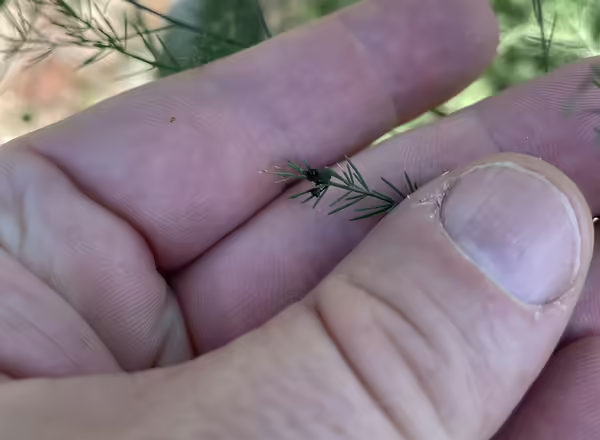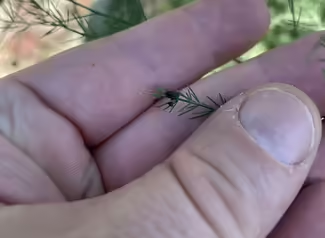There are two species of asparagus beetles that can be found in Illinois, the common asparagus beetle and the spotted asparagus beetle. Both species are oval-shaped and around ¼ inch long.
- Common asparagus beetle (Crioceris asparagi) adults are bluish-black with six cream-colored elongate spots on their backs. The larvae are gray with a black head and have a somewhat slug-like appearance.
- Spotted asparagus beetles (Crioceris duodecimpunctata) are reddish-orange with twelve small black dots on the back. The larva are orange. The adults will feed on asparagus spears. The cream-colored larvae feed primarily on asparagus berries.
Asparagus beetle adults are about 1/4 inch long, oval in shape, brightly colored in blue and brown, with cream-colored elongate spots on the back. Spotted asparagus beetle is orange with many small black dots on the back. Asparagus beetles lay clusters of yellow eggs on the asparagus spears and ferns; spotted asparagus beetles lay similar eggs only on the ferns. The larvae of both species are soft-bodied, elongate, and about 1/4 inch long when full grown. Asparagus beetle larvae are gray; spotted asparagus beetle larvae are cream colored.
The adults chew notches in the spears, reducing their market value. Asparagus beetle eggs on the spears also reduce their market value. Both the larvae and adults of the asparagus beetle feed on the ferns. Severe fern damage can reduce spear production the following year.

The adult beetles will feed on asparagus spears, which can cause them to be deformed and stunted. Both the larvae and adults of the asparagus beetle feed on the ferns. Severe fern damage can reduce spear production the following year. If populations are high enough, plants may be defoliated, which will weaken plants.
Asparagus beetle overwinters as adults in sheltered areas such as leaf litter and in the hollow stems of old asparagus plants. Common asparagus beetles will emerge earlier than spotted when spears begin emerging in the spring.
The adults begin feeding immediately after emergence and egg laying begins one week after. The eggs are laid in rows of 3 to 8 eggs on spears. Larval feeding lasts for about two weeks. Mature larvae move to the ground and burrow in the soil where it pupates.
Spotted asparagus beetle larvae live and feed within the developing asparagus berries. The use of male-only varieties eliminates this beetle as a pest. Their natural enemy is a tiny wasp that feeds on eggs and lays its eggs inside the beetle’s egg.
Gardeners: Monitor for adults and eggs on spears in early spring. Control by handpicking the beetles or destroying eggs before they hatch in home gardens. For larger plantings or when large beetle populations are present, insecticides can be used. Contact your county Extension office for current pesticide controls. Spray when
- 10% or more of plants have adult asparagus beetles
- 50 to 75% of the plants have larvae
- 2% or more of spears have eggs on them
Commercial: Treat spears during the harvest season if infestations of either species exceed five to ten adults per 100 crowns, or if eggs are present on more than 2 percent of the spears. Treat ferns postharvest if infestations exceed five to ten adults per ten crowns.
Spraying the field edges where the adults overwinter with insecticides (recommended in your state) is an effective control measure. Contact your county Extension office for current pesticide controls.
